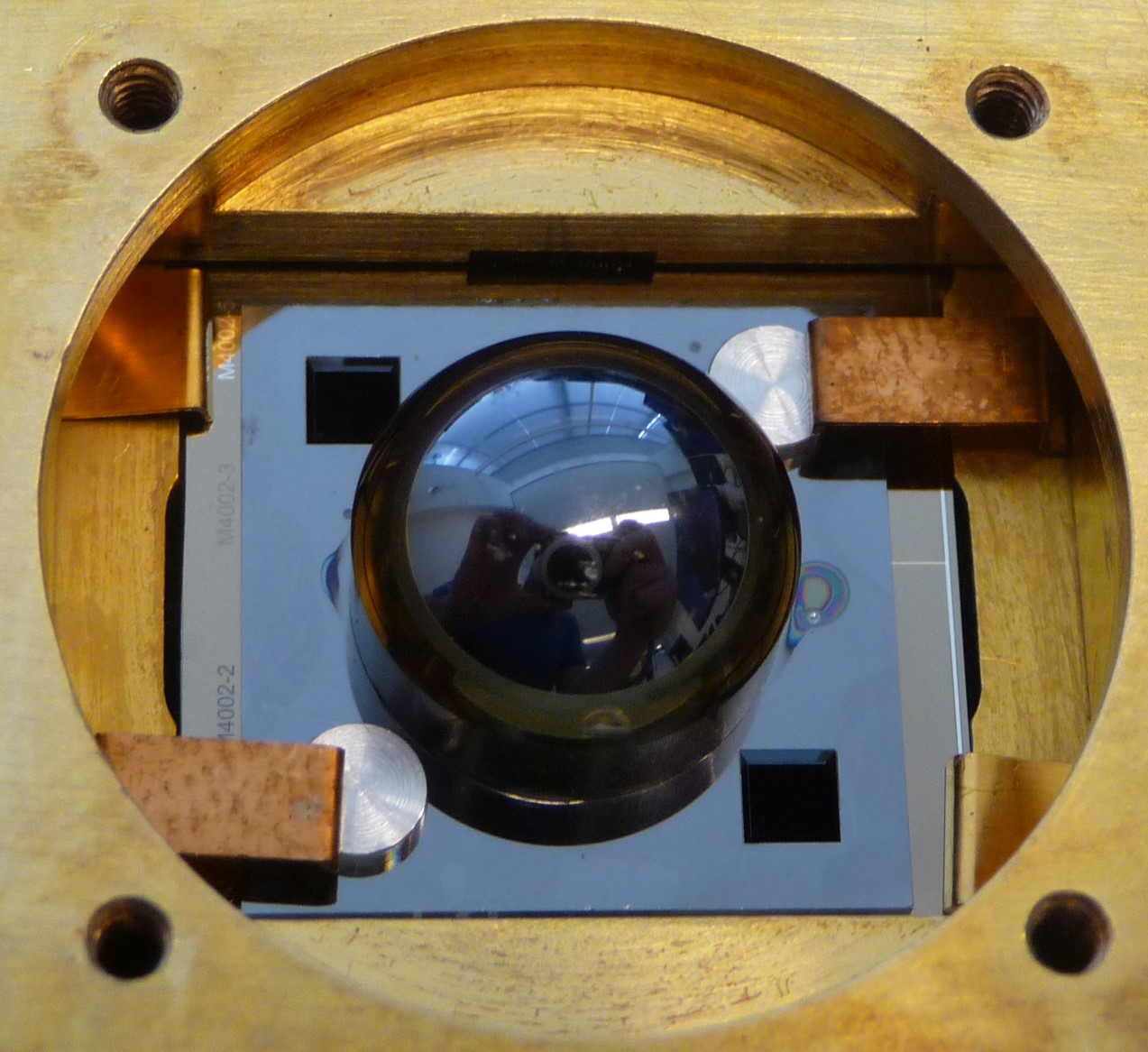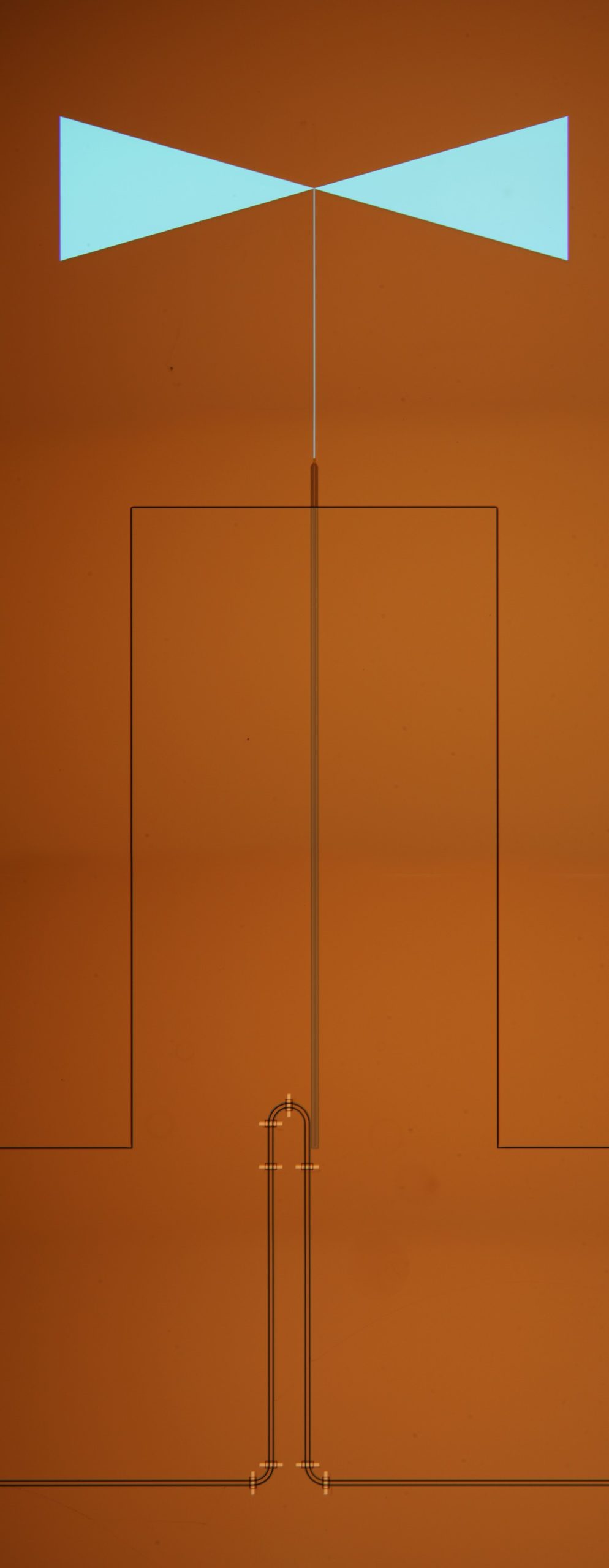(English follows Dutch)
SRON-onderzoekers hebben een concept geoptimaliseerd voor ver-infrarooddetectie op meerdere frequenties. Kinetic Inductance Detectors (KIDs) zijn gevoelig voor een brede frequentieband als er een laagje lucht zit tussen lens en antenne—het leaky lens concept. De wetenschappers hebben de ideale breedte van de luchtlaag bepaald en de optimale vorm gevonden voor de antenne en de lens.
 The full chip with lens mounted in the sample holder
The full chip with lens mounted in the sample holderAls je astronomische interesses uitgaan naar neutronensterren of sterren zoals de zon, heb je geluk. Die objecten zenden meestal respectievelijk radiostraling en zichtbaar licht uit. De detectietechnieken voor die golflengtes hebben een lange geschiedenis en enkele praktische voordelen. Radiogolven zijn bijvoorbeeld lang, dus je hebt macroscopische antennes nodig die je met je handen kunt bouwen. En om zichtbaar licht te detecteren, kun je conventionele CCD-technologie gebruiken.
Mensen die geïnteresseerd zijn in de geboorte van planetenstelsels of verre sterrenstelsels hebben minder geluk, omdat die ver-infraroodlicht uitzenden, met een golflengte tussen die van radio en zichtbaar licht. Ver-infrarooddetectoren hebben een kortere ontwikkelingsgeschiedenis en hun technologie is gebaseerd op het notoir moeilijk te hanteren principe van supergeleiding en kleine antennes van microscopisch kleine omvang. Toch gaan SRON-wetenschappers de uitdaging aan: ze werken aan een ver-infraroodtechnologie genaamd Kinetic Inductance Detectors (KIDs). Ze hebben nu een belangrijke hindernis overwonnen in het ontwikkelingsproces.

KIDs detecteren ver-infraroodfotonen door de kinetische inductie in een supergeleidend materiaal te monitoren. Je kunt kinetische inductie zien als de traagheid van elektronen. Die neemt toe naarmate het materiaal een deel van zijn supergeleiding verliest, of met andere woorden, wanneer de elektronen minder Cooperparen vormen. En dat is precies wat er gebeurt als ver-infraroodfotonen vanuit de ruimte het materiaal raken. Dus wanneer een KID een toename in kinetische inductie meet, detecteert het de facto inkomende fotonen.
Jochem Baselmans en zijn team, waaronder eerste auteur Sebastian Hähnle, hebben het zogenoemde leaky lens concept nu geoptimaliseerd voor KID-technologie. Leaky lens antennes maken stralingsdetectie mogelijk in een brede frequentieband. Er zit een dun laagje lucht tussen de lens en de antenne, zodat de brekingswet van Snellius de lichtstralen opdraagt om een scherpe bocht te maken nadat ze door de lens zijn gegaan. Daardoor komen ze op de antenne terecht. Zonder de luchtlaag zouden lichtstralen uit een groot deel van het spectrum de antenne missen omdat de lens ze niet genoeg ombuigt. De onderzoekers hebben het leaky lens concept geoptimaliseerd door de ideale breedte van de luchtlaag te bepalen en de optimale vorm van de antenne en de lens te kiezen.
Publicatie
Sebastian Hähnle, Ozan Yurduseven, Sven van Berkel, Nuria Llombart, Juan Bueno, Stephen J. C. Yates, Vignesh Murugesan, David J. Thoen, Andrea Neto, Jochem J. A. Baselmans, ‘An Ultra-wideband antenna for broadband spectroscopic imaging applications’, IEEE Transactions on Antennas and Propagation
Leaky Lens Antenna optimized for far-infrared detection at multiple frequencies
SRON researchers have optimized a concept for far-infrared detection at multiple frequencies. Kinetic Inductance Detectors (KIDs) are sensitive to a wide frequency band if there is a layer of air between lens and antenna—the leaky lens concept. The scientists determined the optimal width of the air layer and found the optimal shape for the antenna and the lens.
If your astronomical interests are towards neutron stars or regular stars like the Sun, you are in luck. Those objects emit mostly respectively radio and visual light. The detection techniques for those wavelengths have a long history and some practical advantages. For example, radio waves are long, so you need macroscopic antennas that you can build with your hands. And to detect visible light you can use conventional CCD technology.
People interested in the birth of planetary systems or early galaxies are less fortunate, as those emit far-infrared radiation, with a wavelength in between radio and visible light. Far-infrared detectors have a shorter development history, plus their technology is based on the notoriously difficult-to-handle principle of superconductivity and small antennas of microscopic proportions. Still, SRON-scientists take on the challenge—they are working on a far-infrared technology called Kinetic Inductance Detectors (KIDs). They have now overcome an important hurdle in the development process.
KIDs detect far-infrared photons by monitoring the kinetic inductance in a superconducting material. You can think of kinetic inductance as the inertia of electrons. That increases as the material loses some of its superconductivity, or in other words, when the electrons form less Cooper pairs. And that is exactly what happens when far-infrared photons from space hit the material. So when a KID measures an increase in kinetic inductance, it de facto detects incoming photons.
Jochem Baselmans and his team, including first author Sebastian Hähnle, have now optimized the so-called leaky lens antenna concept for KID technology. Leaky lens antennas allow radiation detection in a wide band of frequencies. There is a thin layer of air between the lens and the antenna, so that Snell’s law of refraction tells the light rays to make a sharp turn after passing through the lens and therefore hit the antenna. Without the air layer, rays from a large part of the spectrum would miss the antenna because the lens doesn’t bend them enough. The researchers optimized the leaky lens antenna concept by determining the best width of the air layer and the ideal shape of the antenna and the lens.
Publication
Sebastian Hähnle, Ozan Yurduseven, Sven van Berkel, Nuria Llombart, Juan Bueno, Stephen J. C. Yates, Vignesh Murugesan, David J. Thoen, Andrea Neto, Jochem J. A. Baselmans, ‘An Ultra-wideband antenna for broadband spectroscopic imaging applications’, IEEE Transactions on Antennas and Propagation


